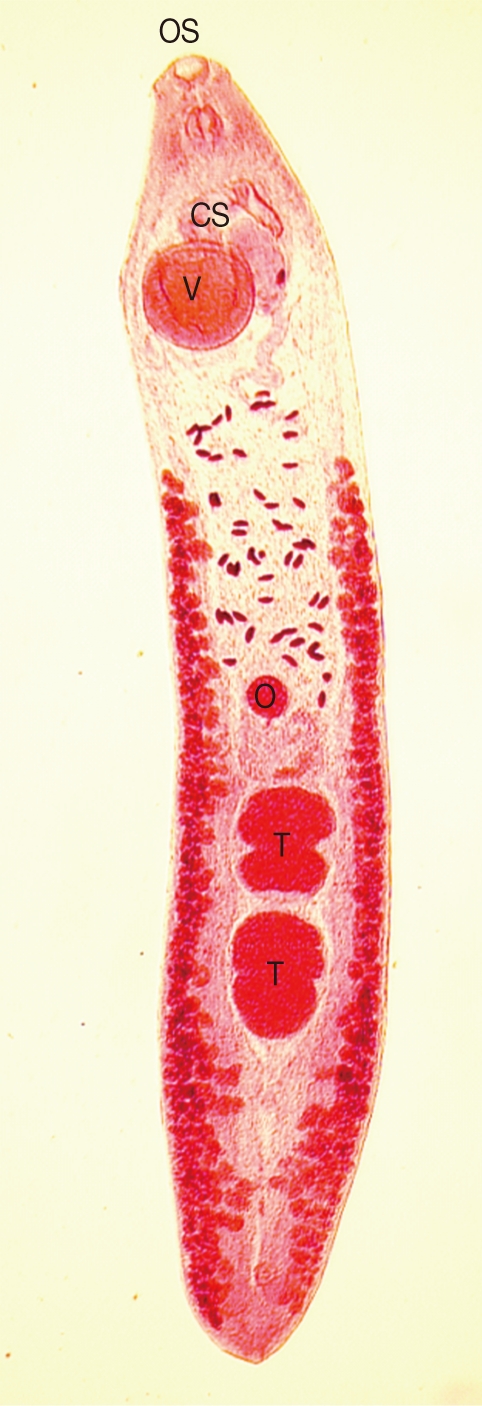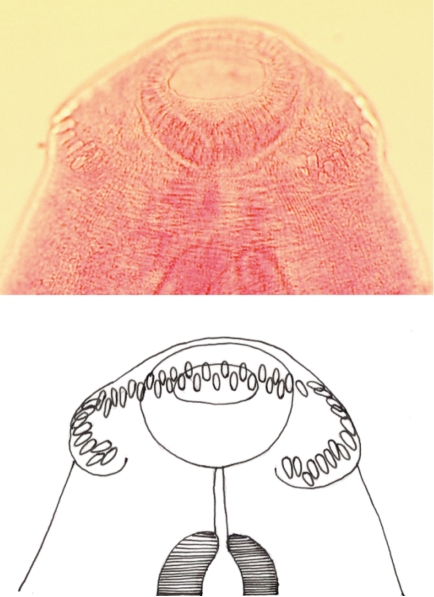Cited By
Citations to this article as recorded by

Current status of food-borne trematode infections
R. Toledo, J. G. Esteban, B. Fried
European Journal of Clinical Microbiology & Infectious Diseases.2012; 31(8): 1705.
CrossRef High prevalence of large trematode eggs in schoolchildren in Cambodia
Philipp J. Bless, Fabian Schär, Virak Khieu, Stefanie Kramme, Sinuon Muth, Hanspeter Marti, Peter Odermatt
Foodborne intestinal flukes: A brief review of epidemiology and geographical distribution
Jong-Yil Chai, Bong-Kwang Jung
Acta Tropica.2020; 201: 105210.
CrossRef Development and utilization of a visual loop-mediated isothermal amplification coupled with a lateral flow dipstick (LAMP-LFD) assay for rapid detection of Echinostomatidae metacercaria in edible snail samples
Wasin Panich, Phonkawin Jaruboonyakorn, Awika Raksaman, Thanawan Tejangkura, Thapana Chontananarth
International Journal of Food Microbiology.2024; 418: 110732.
CrossRef The current status of opisthorchiasis and clonorchiasis in the Mekong Basin
Paiboon Sithithaworn, Ross H. Andrews, Nguyen Van De, Thitima Wongsaroj, Muth Sinuon, Peter Odermatt, Yukifumi Nawa, Song Liang, Paul J. Brindley, Banchob Sripa
Parasitology International.2012; 61(1): 10.
CrossRef Neglected food-borne trematodiases: echinostomiasis and gastrodiscoidiasis
Rafael Toledo, María Álvarez-Izquierdo, J. Guillermo Esteban, Carla Muñoz-Antoli
Parasitology.2022; 149(10): 1319.
CrossRef General overview of the current status of human foodborne trematodiasis
Jong-Yil Chai, Bong-Kwang Jung
Parasitology.2022; 149(10): 1262.
CrossRef Detection of echinostomatid trematode eggs at the forest–oil palm interface in Sabah, Malaysia
Liesbeth Frias, Benny Obrain Manin, Sergio Guerrero-Sánchez, Symphorosa Sipangkui, Tock H. Chua
Potentially Zoonotic Helminthiases of Murid Rodents from the Indo-Chinese Peninsula: Impact of Habitat and the Risk of Human Infection
Kittipong Chaisiri, Praphaiphat Siribat, Alexis Ribas, Serge Morand
Vector-Borne and Zoonotic Diseases.2015; 15(1): 73.
CrossRef Prevalence of Foodborne Trematodes in Small Indigenous Fish Species in Local Markets of Phnom Penh, Cambodia
Domenico Caruso, Lin Kong, Samnang Keo, Sreyni Yoeurn, Samphal Seng
Vector-Borne and Zoonotic Diseases.2024; 24(3): 141.
CrossRef Changing Patterns of Gastrointestinal Parasite Infections in Cambodian Children: 2006-2011
C. E. Moore, P. C. Hor, S. Soeng, S. Sun, S. J. Lee, C. M. Parry, N. P. J. Day, N. Stoesser
Journal of Tropical Pediatrics.2012; 58(6): 509.
CrossRef An update on human echinostomiasis
R. Toledo, J. G. Esteban
Transactions of The Royal Society of Tropical Medicine and Hygiene.2016; 110(1): 37.
CrossRef Repertory of eukaryotes (eukaryome) in the human gastrointestinal tract: taxonomy and detection methods
I. Hamad, D. Raoult, F. Bittar
Parasite Immunology.2016; 38(1): 12.
CrossRef Human echinostomiasis: a case report
Ranjit Sah, Shusila Khadka, Rabin Hamal, Sagar Poudyal
High Prevalence of Echinostoma mekongi Infection in Schoolchildren and Adults, Kandal Province, Cambodia
Bong-Kwang Jung, Taehee Chang, Seungwan Ryoo, Sooji Hong, Jeonggyu Lee, Sung-Jong Hong, Woon-Mok Sohn, Virak Khieu, Rekol Huy, Jong-Yil Chai
Emerging Infectious Diseases.2024;[Epub]
CrossRef Zoonotic Echinostome Infections in Free-Grazing Ducks in Thailand
Weerachai Saijuntha, Kunyarat Duenngai, Chairat Tantrawatpan
The Korean Journal of Parasitology.2013; 51(6): 663.
CrossRef A Case of Echinostoma cinetorchis (Trematoda: Echinostomatidae) Infection Diagnosed by Colonoscopy
Woon Tae Jung, Kyeong Ju Lee, Hong Jun Kim, Tae Hyo Kim, Byoung-Kuk Na, Woon-Mok Sohn
The Korean Journal of Parasitology.2014; 52(3): 287.
CrossRef Prevalence of Intestinal Helminths among Inhabitants of Cambodia (2006-2011)
Tai-Soon Yong, Jong-Yil Chai, Woon-Mok Sohn, Keeseon S. Eom, Hoo-Gn Jeoung, Eui-Hyug Hoang, Cheong-Ha Yoon, Bong-Kwang Jung, Soon-Hyung Lee, Muth Sinuon, Duong Socheat
The Korean Journal of Parasitology.2014; 52(6): 661.
CrossRef Artyfechinostomum malayanum: Metacercariae Encysted in Pila sp. Snails Purchased from Phnom Penh, Cambodia
Woon-Mok Sohn, Tai-Soon Yong, Keeseon S. Eom, Muth Sinuon, Hoo-Gn Jeoung, Jong-Yil Chai
The Korean Journal of Parasitology.2017; 55(3): 341.
CrossRef Echinostoma ilocanum Infection in Two Residents of Savannakhet Province, Lao PDR
Jong-Yil Chai, Woon-Mok Sohn, Jaeeun Cho, Keeseon S. Eom, Tai-Soon Yong, Duk-Young Min, Eui-Hyug Hoang, Bounlay Phommasack, Bounnaloth Insisiengmay, Han-Jong Rim
The Korean Journal of Parasitology.2018; 56(1): 75.
CrossRef Echinostoma mekongi n. sp. (Digenea: Echinostomatidae) from Riparian People along the Mekong River in Cambodia
Jaeeun Cho, Bong-Kwang Jung, Taehee Chang, Woon-Mok Sohn, Muth Sinuon, Jong-Yil Chai
The Korean Journal of Parasitology.2020; 58(4): 431.
CrossRef





